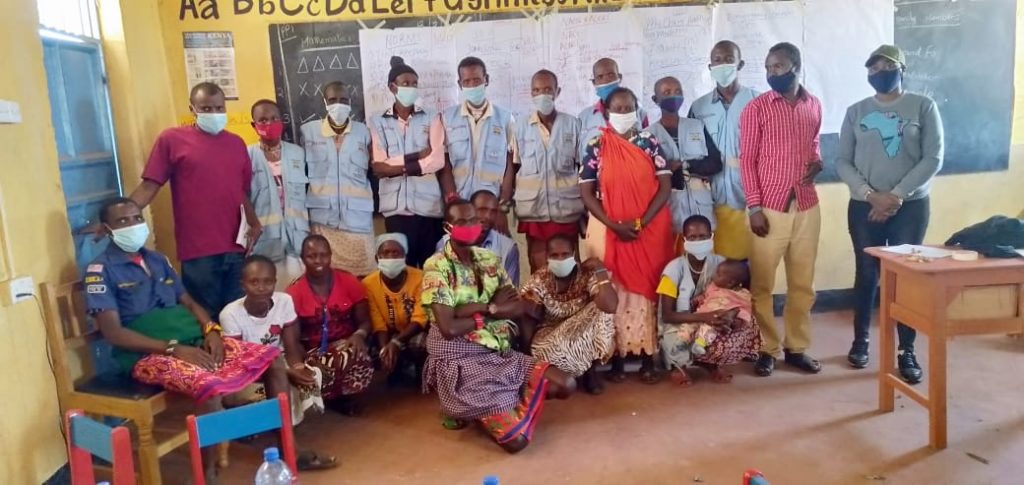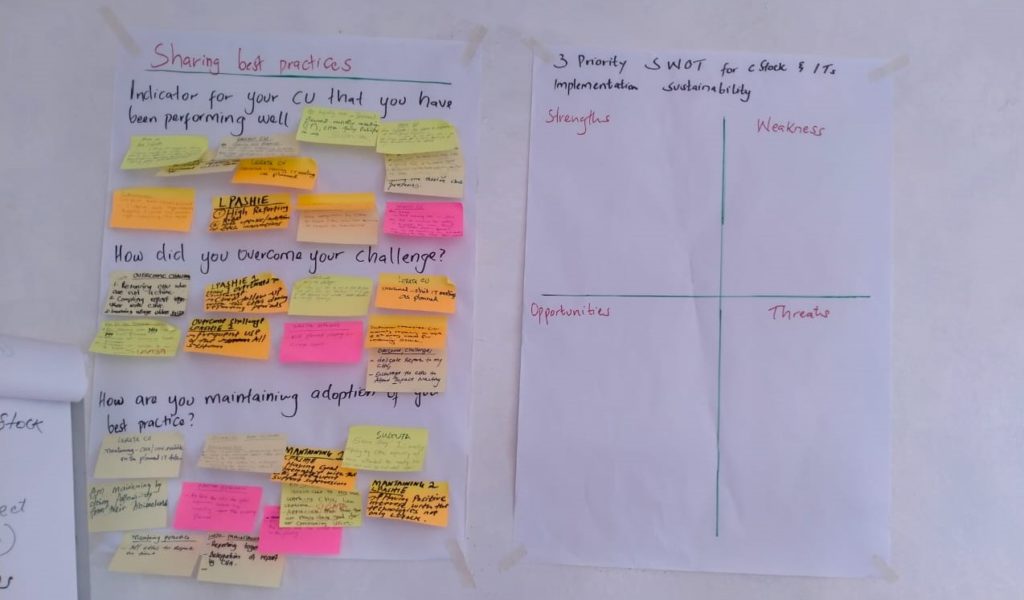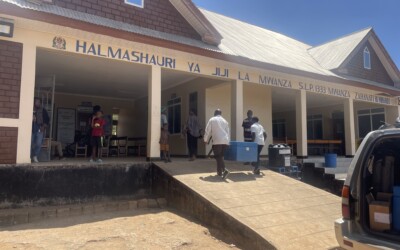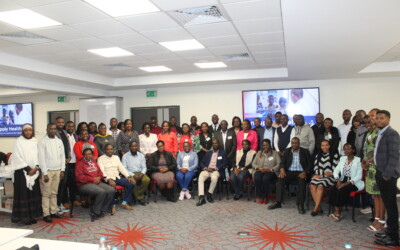inSupply Health believes that solutions applied at every level of the supply chain outlive specific projects or funding streams. What does that mean, and how does it look in practice? What challenges have we faced during implementation? We answer these questions as we look back at one of our projects that is nearing completion.
The Supply Chain Alternatives for Last Mile Equity (SCALE) project, funded by the Bill & Melinda Gates Foundation, aimed to increase equity in access to health commodities by developing sustainable and scalable community-based commodity distribution models. SCALE focused its work in Kenya’s Mandera, Wajir, Turkana, and Samburu Counties, which are located in the arid and semiarid lands (ASAL). People in these counties have limited access to health care services, and use of family planning is low.

The project aimed to build capacity and share lessons from its sustainable approaches and implementation strategies, which included Developmental Evaluation (DE), cStock, and Information Mobilized for Performance Analysis and Continuous Transformation (IMPACT) Teams.
Generating Evidence Using Developmental Evaluation
SCALE embedded the DE approach to facilitate collaborative learning and continuous improvement in three community health projects. Through DE, the projects generated evidence and learning for sustainable and comprehensive community health models. inSupply identified and documented the process of implementing and adapting supply chain and service delivery models in ASAL counties. Insight from this work is applicable to those working with similar populations in other countries in the sub-region, the Horn of Africa, and the Sahel, and will contribute to the success of future programming on continuous health supply chain improvement.
Data and Impact Sustainability via cStock
SCALE also deployed cStock, a supply chain strengthening solution that combines simple resupply procedures using mobile technology with user-friendly dashboards for performance monitoring. In partnership with the Division of Community Health Services and Division of Health Informatics of the Ministry of Health (MOH), cStock was integrated with Kenya Health Information System (KHIS) as part of the sustainability strategy and scale up plan.
Integrating cStock made it easier for KHIS users to access health commodity data. Users can compare data from reports that community health volunteers (CHVs) submit through cStock across community units in respective counties and seamlessly trace resupply bits. With the availability of consumption data (stock on hand and dispense indicators), county and implementing partners are able to better understand and communicate their achievements in distributing commodities to underserved communities in hard-to-reach areas. The data also allow partner organizations to adjust budgets for health commodity procurement and mobilize additional funding as needed. Recognizing this value, partners such as Save the Children are adopting the cStock approach, and the county government teams, with support from inSupply Health, are mentoring them.
cStock has improved community-based distribution policies and structures, and all four SCALE counties are advocating its expansion to additional counties and sub-counties in Kenya. MOH recognized cStock’s contribution to strengthening supply chain management and has recommended its integration with the electronic community health information system.
Putting People at the Center through IMPACT Teams
IMPACT Teams is a structured supply chain problem-solving and action planning approach for enhancing individual and team continuous performance improvement. Building capacity is a critical component of IMPACT Teams. inSupply Health introduced e-Learning Packages, a virtual, self-paced, modular course that targets four core IMPACT Teams competencies. These packages allow health care workers to continue their professional development while learning applicable skills. By putting people’s capacity and processes at the center of our solution, inSupply had more sustainable results.
Implementation strategies
County and sub-county training-of-trainers on IMPACT Teams and cStock approaches ensure that MOH has a pool of trainers to fill gaps from staff turnover. The project developed cStock standard operating procedures as a resource for community health assistants (CHAs), CHVs, and new team members. Using human-centered design (HCD) to contextualize the solutions helped us gain insights into people’s needs, desires, and practical barriers to using these approaches. By customizing our approaches to meet people’s needs, we increased uptake.
inSupply ensured that IMPACT Teams meetings were integrated with others such as commodity security technical working group and data review and health management team meetings. Transitioning these approaches to county governments was crucial to ensure continuity and ownership, and the process was preceded by partner mapping, followed by county and partner Strength, Weakness, Opportunities, and Threats analysis, which informed focus areas for transition and culminated in a workshop at which counties developed sustainability action plans and scopes of work.

During the project close-out workshop in the four counties, implementing partners in Samburu and Turkana expressed interest in adopting the approaches for their project. Programs such as cStock will be used by CHVs to monitor nutrition commodity supply. Furthermore, county governments developed a plan to continue implementing the approaches, assigning responsibility to respective county officers for each action item.
Challenges
SCALE initially planned to build and support forecasting of commodities at county levels to ensure cStock and Indicator Tracking Tool (ITT) data could be used to promote better commodity resupply practices. To avoid duplication of efforts with other projects focusing on the same area, SCALE instead focused on providing technical support.
inSupply emphasizes a structured data review approach that includes identification of challenges based on the performance, root cause analysis, and action planning. Prioritizing data review meetings remains a challenge; meetings are irregular and inconsistent. The CHAs invited the health facility in-charges to the meetings, which enhanced working relationships and expedited on commodity release to the CHVs. While SCALE’s introduction of the IMPACT Teams approach reduced these meeting inconsistencies, its continuity is not assured beyond project implementation.
Behavior change takes time. There is still low demand for family planning information and services in these counties. We need continued advocacy to increase interest among nomadic and semi-nomadic pastoralist communities at local, national, and global levels. This is important for scaling up the intervention in other geographies.
Lessons
Previously, projects focused on developing exit plans that detailed strategies to ensure sustainability. Some of these plans were one-sided from the perspective of the implementing partner and lacked input from the communities in which they operated. As a result, the implementation of these plans was so challenging that it was difficult to sustain the gains of some of the projects.
The following are some lessons on structuring and implementing projects in a sustainable manner:
- Embed sustainability throughout the life of the project. For better outcomes, sustainability should be infused in the design of the approaches that will be implemented, and improved and strengthened throughout the project.
- Strong collaboration. DE was instrumental to collaborative learning and continuous improvement in the SCALE project. Coupling this with HCD, which focuses on ideation and co-creation of solutions that respond to the needs of users, was instrumental in achieving buy-in and collaboration from stakeholders. The cascaded training for the multiple approaches that we implemented in the SCALE project was also effective.
- High cost of implementation impedes sustainability, especially for county governments. We were deliberate in ensuring that ITT, cStock, and the IMPACT Teams approach and the self-paced learning packages had low costs for the counties that adopted them.
- Co-create sustainability plans. There are better results when sustainability plans are co-created with the MOH and other partners working in the same geography, even when the funding streams are different.


